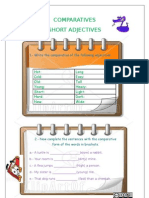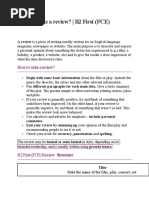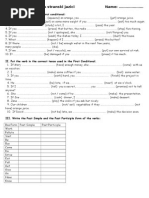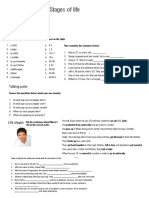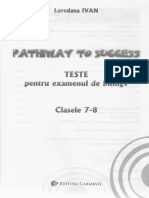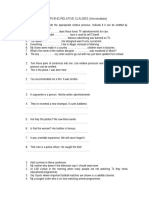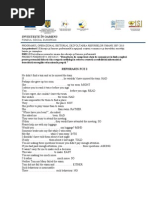0 ratings0% found this document useful (0 votes)
422 viewsVerb To Be Mistakes
Verb To Be Mistakes
Uploaded by
Hatice AydinThis document uses incorrect verb conjugations of "to be" in various sentences describing subjects and their actions or attributes. It provides examples of "are", "is", "am", "aren't", and "isn't" being used incorrectly with subjects including "I", "you", "he", "she", "we", and "they".
Copyright:
© All Rights Reserved
Available Formats
Download as DOCX, PDF, TXT or read online from Scribd
Verb To Be Mistakes
Verb To Be Mistakes
Uploaded by
Hatice Aydin0 ratings0% found this document useful (0 votes)
422 views2 pagesThis document uses incorrect verb conjugations of "to be" in various sentences describing subjects and their actions or attributes. It provides examples of "are", "is", "am", "aren't", and "isn't" being used incorrectly with subjects including "I", "you", "he", "she", "we", and "they".
Original Description:
verb to be, mistake for finding
Original Title
Verb to Be Mistakes
Copyright
© © All Rights Reserved
Available Formats
DOCX, PDF, TXT or read online from Scribd
Share this document
Did you find this document useful?
Is this content inappropriate?
This document uses incorrect verb conjugations of "to be" in various sentences describing subjects and their actions or attributes. It provides examples of "are", "is", "am", "aren't", and "isn't" being used incorrectly with subjects including "I", "you", "he", "she", "we", and "they".
Copyright:
© All Rights Reserved
Available Formats
Download as DOCX, PDF, TXT or read online from Scribd
Download as docx, pdf, or txt
0 ratings0% found this document useful (0 votes)
422 views2 pagesVerb To Be Mistakes
Verb To Be Mistakes
Uploaded by
Hatice AydinThis document uses incorrect verb conjugations of "to be" in various sentences describing subjects and their actions or attributes. It provides examples of "are", "is", "am", "aren't", and "isn't" being used incorrectly with subjects including "I", "you", "he", "she", "we", and "they".
Copyright:
© All Rights Reserved
Available Formats
Download as DOCX, PDF, TXT or read online from Scribd
Download as docx, pdf, or txt
You are on page 1of 2
Verb to be
She are ten years old.
They is from London.
We is in school working.
You is beautiful.
I is going to the beach.
He are watching TV.
She arent playing tennis.
He arent cooking dinner.
They isnt going to the cinema.
We isnt going for a run.
I isnt jumping on the bed.
You isnt ugly.
You might also like
- Test Oral Engleza Clasa A 5-ADocument1 pageTest Oral Engleza Clasa A 5-ALorenaUrs100% (3)
- B1+ UNITS 5 and 6 CLILDocument2 pagesB1+ UNITS 5 and 6 CLILmonika krajewskaNo ratings yet
- 5 Minute Activity ChristmasDocument1 page5 Minute Activity ChristmasCal VariumNo ratings yet
- Gold Experience B2 For Schools. Unit 1 Comparative & Superlatives & Too & EnoughDocument2 pagesGold Experience B2 For Schools. Unit 1 Comparative & Superlatives & Too & EnoughPenny RivasNo ratings yet
- New Snapshot Placement TestDocument13 pagesNew Snapshot Placement TestOana Adriana Stroe100% (2)
- Grammar Out and AboutDocument1 pageGrammar Out and AboutMarta Sampedro GonzalezNo ratings yet
- Have - Got - Exercises 2 PDFDocument2 pagesHave - Got - Exercises 2 PDFRoxana TudoseNo ratings yet
- Present Simple VS Present Continuous VS Past SimpleDocument1 pagePresent Simple VS Present Continuous VS Past Simpletrbe8sNo ratings yet
- Compact PFS TG Unit Test 1 - StandardDocument1 pageCompact PFS TG Unit Test 1 - StandardHuyền TrangNo ratings yet
- Comparatives Short AdjectivesDocument2 pagesComparatives Short Adjectivesprofeglori1484100% (4)
- Rephrasing CaeDocument1 pageRephrasing CaeIulia AdelinaNo ratings yet
- 127hours WorksheetDocument3 pages127hours WorksheetVictor Manuel Guevara Leyva0% (1)
- Tenses Review (B1)Document2 pagesTenses Review (B1)Stella KoutsiNo ratings yet
- Present Simple/ Present Continuous/ Past Simple/ Past ContinuousDocument1 pagePresent Simple/ Present Continuous/ Past Simple/ Past ContinuousMontseNo ratings yet
- How To Write A ReviewDocument7 pagesHow To Write A ReviewDARIA DINCĂNo ratings yet
- Perspectives Intermediate Unit 2 Sample UnitDocument6 pagesPerspectives Intermediate Unit 2 Sample UnitGwen GalaNo ratings yet
- Past Simple or Present Perfect ExercisesDocument2 pagesPast Simple or Present Perfect ExercisesTransportes logisticaNo ratings yet
- First Conditional Present Perfect Irregular VerbsDocument3 pagesFirst Conditional Present Perfect Irregular Verbsslavica_volkanNo ratings yet
- Face 2 Face Intermediate ReviewDocument3 pagesFace 2 Face Intermediate ReviewThiago DargainsNo ratings yet
- Exam Choices Extra Vocabulary ActivitiesDocument17 pagesExam Choices Extra Vocabulary Activitiesiren.tishkinaNo ratings yet
- Beyond B1 December Exam Revision EasyDocument4 pagesBeyond B1 December Exam Revision EasyMacaNo ratings yet
- For & Against Essays: A Good Essay of This Type Should Consist ofDocument4 pagesFor & Against Essays: A Good Essay of This Type Should Consist ofDUL100% (5)
- Complete First - Test Unit Test 1 (STANDARD)Document2 pagesComplete First - Test Unit Test 1 (STANDARD)Alba NovoaNo ratings yet
- My Favorite HolidayDocument1 pageMy Favorite HolidayEstefany Cris De la Cruz MezaNo ratings yet
- Test Unit 1 Complet CaeDocument4 pagesTest Unit 1 Complet CaeGabriela DayanNo ratings yet
- B2.1.Christmas Listening Test.2020.2021Document3 pagesB2.1.Christmas Listening Test.2020.2021Nuno RibeiroNo ratings yet
- Present Continuous ExerciseDocument1 pagePresent Continuous ExerciseSaleh MohammadNo ratings yet
- Pulse 1 End-Of-Year Exam Basic Units 1-9Document19 pagesPulse 1 End-Of-Year Exam Basic Units 1-9neusNo ratings yet
- Mystery Stories: Narrative TensesDocument4 pagesMystery Stories: Narrative TensesAsshiyyatul Fitryy AwaqNo ratings yet
- Rephrasing C1Document7 pagesRephrasing C1Pablo AlejandroNo ratings yet
- THINK L0 Unit 4 GrammarDocument2 pagesTHINK L0 Unit 4 Grammarsol_zota13No ratings yet
- B2 First Unit 11 Test: VocabularyDocument3 pagesB2 First Unit 11 Test: VocabularyNatalia KhaletskaNo ratings yet
- Adjectives To Describe Films PDFDocument1 pageAdjectives To Describe Films PDFĐào Ngọc ThuýNo ratings yet
- Life Stages PDFDocument2 pagesLife Stages PDFAna IbanezNo ratings yet
- Pathway To Success Clasele 7-8 - Loredana IvanDocument5 pagesPathway To Success Clasele 7-8 - Loredana IvanDenysse Denysse0% (1)
- Modelo de Evaluacion Senior 6 AACI PDFDocument5 pagesModelo de Evaluacion Senior 6 AACI PDFEstefania PaulozzoNo ratings yet
- 0 Lesson Plan WeatherDocument2 pages0 Lesson Plan WeatherAlexandra TurcuNo ratings yet
- Use of EnglishDocument24 pagesUse of Englishjaka.delcnjakNo ratings yet
- Initial Test 7th GradeDocument2 pagesInitial Test 7th GradeLavinia Odobasianu100% (1)
- Booster B2 Part 1Document6 pagesBooster B2 Part 1MartaNo ratings yet
- Close Up B2 PLAN MESIMORDocument1 pageClose Up B2 PLAN MESIMORFatjona Cibuku HysolliNo ratings yet
- Defining & Non-Defining Relative Clauses (Intermediate)Document2 pagesDefining & Non-Defining Relative Clauses (Intermediate)Rosana Costa0% (2)
- Robbieenglishteacher Lesson 2Document4 pagesRobbieenglishteacher Lesson 2Andreia SimõesNo ratings yet
- My Favourite MoviesDocument1 pageMy Favourite Moviesariolicub84100% (1)
- Daily Routine - Reading ComprehensionDocument2 pagesDaily Routine - Reading ComprehensionMarina GomesNo ratings yet
- FCE Rephrase Exercises 2Document2 pagesFCE Rephrase Exercises 2Lucia BalaneanNo ratings yet
- Phrasal Verbs Wordsearch PDFDocument2 pagesPhrasal Verbs Wordsearch PDFaas0% (1)
- Practice: Present Perfect Simple and ContinuousDocument2 pagesPractice: Present Perfect Simple and ContinuousDebora Duran San RomanNo ratings yet
- Worksheet 01 - Personal Pronouns, Indefinite Articles and To BeDocument2 pagesWorksheet 01 - Personal Pronouns, Indefinite Articles and To BeCristhian Castillo MoránNo ratings yet
- Destination B1 UNIT 1-2 Grammar Handout Filling in & Making QuestionsDocument1 pageDestination B1 UNIT 1-2 Grammar Handout Filling in & Making QuestionsmkNo ratings yet
- Past Simple Vs Past Continuous - Differences - TheoryDocument3 pagesPast Simple Vs Past Continuous - Differences - TheoryOana Dinu100% (1)
- Initial Test 8th GradeDocument2 pagesInitial Test 8th GradeDaianaZideNo ratings yet
- 5th Level English ExamsDocument10 pages5th Level English ExamsBereHgNo ratings yet
- Think 2 Unit 4 Sample UnitDocument10 pagesThink 2 Unit 4 Sample UnitCandelaria Luque100% (1)
- Present Simple and ContinuousDocument7 pagesPresent Simple and Continuouslupumihaela27No ratings yet
- Anna InglésDocument5 pagesAnna InglésEmma GuillermoNo ratings yet
- Essential Grammar in Use 2nd Edition by R. Murphy - Book (1)Document299 pagesEssential Grammar in Use 2nd Edition by R. Murphy - Book (1)nhanhiennguyen0702No ratings yet
- BiografíaDocument1 pageBiografíaTerry Castillo VilchezNo ratings yet
- BBC PDFDocument98 pagesBBC PDFMiguel Angel100% (1)
- Additional Exercises 5 - 7Document2 pagesAdditional Exercises 5 - 7Wagner L MedeirosNo ratings yet
- Reported SpeechDocument7 pagesReported SpeechHatice AydinNo ratings yet
- Synonyms Antonyms WorksheetDocument2 pagesSynonyms Antonyms WorksheetHatice Aydin100% (4)
- Reported Speech 2 QuestionsDocument3 pagesReported Speech 2 QuestionsHatice Aydin100% (1)
- Who Wants To Be A Millionaire?: Adverbs and Adverbial PhrasesDocument61 pagesWho Wants To Be A Millionaire?: Adverbs and Adverbial PhrasesHatice AydinNo ratings yet
- Reported SpeechDocument1 pageReported SpeechHatice AydinNo ratings yet
- Gerunds in Fins Test 2Document3 pagesGerunds in Fins Test 2Hatice AydinNo ratings yet
- Guess The MistakeDocument10 pagesGuess The MistakeHatice AydinNo ratings yet
- Verb (+ Preposition) + Gerund: Reporting Verbs Used With A GerundDocument1 pageVerb (+ Preposition) + Gerund: Reporting Verbs Used With A GerundHatice AydinNo ratings yet
- Ingles Jun Exam SelectividadDocument4 pagesIngles Jun Exam SelectividadHatice AydinNo ratings yet
- ModalsDocument5 pagesModalsHatice Aydin83% (6)
- Exams Firstcert Extra01Document0 pagesExams Firstcert Extra01Hatice AydinNo ratings yet
- Part of Speech Adj: Word Meaning Example Sentence AbnormalDocument13 pagesPart of Speech Adj: Word Meaning Example Sentence AbnormalHatice AydinNo ratings yet









